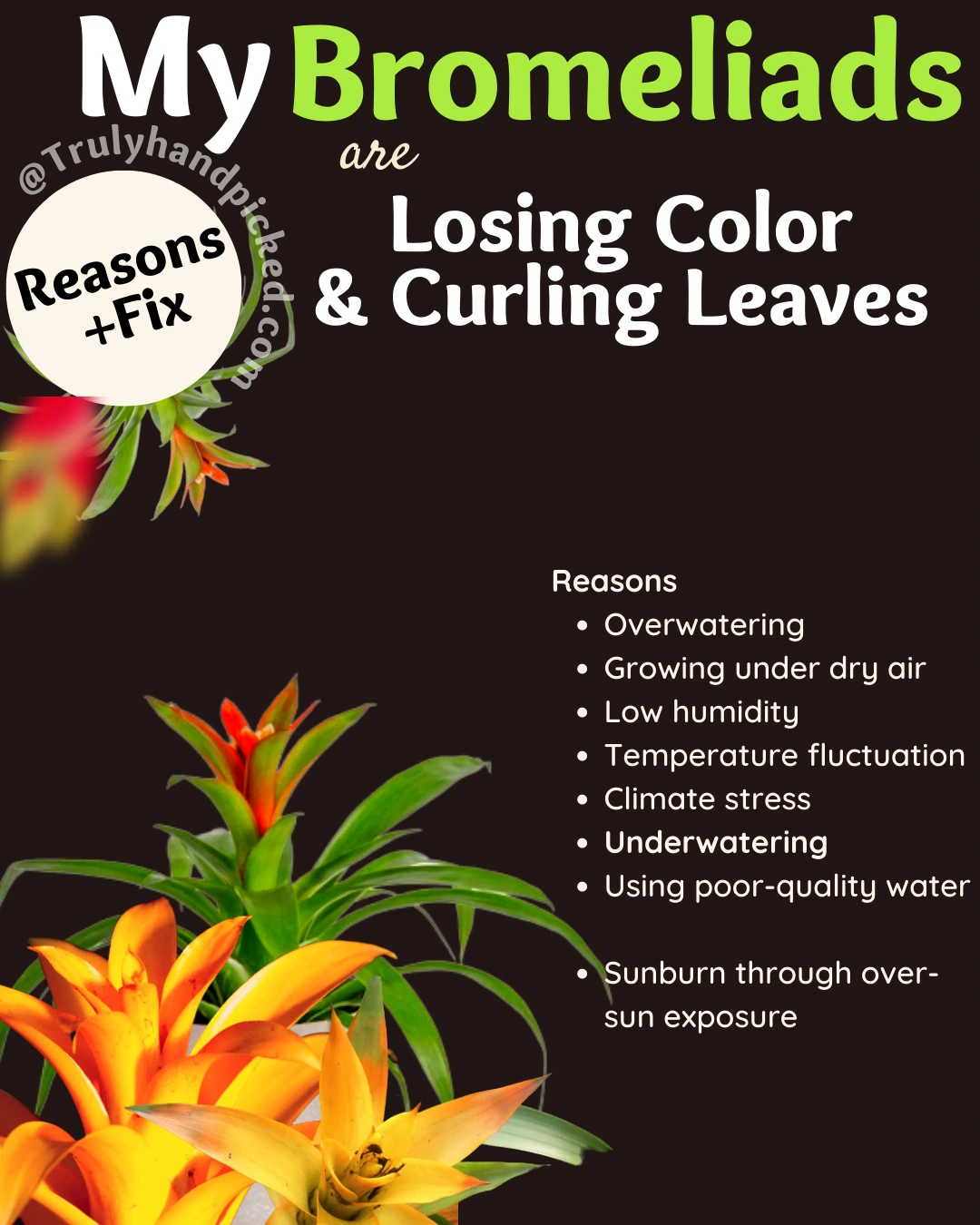Bromeliads are truly attractive and vibrant flowering plants. It belongs to the Bromeliaceae family which includes almost 3600 species from this variety.
This bromeliad plant is one of the most striking ones among them. It has a great natural air-purifying quality and thus, is immensely popular among indoor gardeners.
Details in Short
Bromeliad Color change: Color change is mostly an outcome of low sun exposure which makes your plant leaves turn green to stabilize themselves. Also overwatering and underwatering do contribute points to this color change.
Bromeliad Turns Brown: It’s either your plant has done with its bloom and is about to die and Yes you can cut the spent mother plant. Leaving the pups, cut the main stalk a few inches above. It is its life cycle and you don’t have to feel bad for it.
Few more reasons like lack of moisture to much sun exposure can also turn your bromeliad brown as your leaves have turned dry and crispy
Bromeliads can live up to two to five years with the best care and thriving conditions. However, you must know about a few certain issues of a bromeliad plant to handle it more ideally from all aspects.
So, here is some basic information we have gathered in this regard about a thriving bromeliad plant-
Why is My Bromeliad Turning Brown?
Bromeliads have leathery, waxy, green succulent-type leaves and vibrant flowers in gorgeous raspberry-pink shades. Sometimes, you may find that your green plant eventually may turn brown. It usually happens when the main plant starts dying for unknown reasons.
You must understand that a growing plant doesn’t die all of a sudden without any true cause! Some consistent negligence actions in your plant care routine could be the reason it.
Browning form is just an apparent reminder that your plant is having a hard time and is about to be dying soon. Hence, if you want to avert that inevitable fatal outcome, you should find out the reasons for this troubleshooting issue.
Fixing them properly is equally important before they turn deadly to your bromeliads. Here are some quick tips for this attempt-
Causes and How to Fix Them:
You are overwatering:
- It means you must overwater your plant unnecessarily and repeatedly
- You don’t let the soil of your plant dry between watering
- Your plant roots can’t breathe properly due to a soggy growing medium
Fix:
- Do not water your bromeliads unless the soil turns almost dry
- Never miss your plant during highly humid weather
- Let the excess water drain properly after each watering schedule
Related: Dos and don’t on your bromeliads
Lack of Sunlight:
- Lack of sunlight provides a negative impact on growing bromeliads
- This houseplant requires a certain amount of sunlight to survive
- It also aids them in photosynthesis and blooming
Fix:
- You need to grow this plant in a spot with lots of sunlight
- Make sure the light is bright but indirect
- Provide your bromeliads with six to seven hours of indirect light every day
Improper Humidity:
- One of the main causes of brown bromeliads is the unsuitable humidity level
- If you put your plant under low humidity for long
- Or you may ignore the low-humidity issue for a long that gradually lead to dry and poor soil for your plant
Fix:
- Keep the plant in a spot where the humidity level is always high
- Use an artificial humidifier to keep the humidity level consistently high
- Or you can place the planter in a watery-pebbles tray to provide bromeliads the needed humidity
Excessive Dryness:
- You should remember that excessive dryness is as much bad as overwatering
- The problem starts occurring when you water your plant once a month
- Or your plant roots suffer drought stress due to less-watering
Fix:
- Never let your plant suffer from drought stress
- Follow a proper watering schedule for your growing bromeliads
- Never let the soil completely dry for more than two consecutive weeks
Related: Plants that can withstand harsh weather and dry spells
Pest Attacks:
- As bromeliads grow alluring succulent-type foliage, they often attract pests toward them
- Spider mites, mealybugs, and aphids are some common insects that attack this plant
- They bite the foliage and suck the nutrients from the sap of plants, which drive the plant to the brownish form
Fix:
- Give a good rinse of homemade insecticide sprays to your growing bromeliads
- Neem oil, soapy water, and rubbing alcohol are some inexpensive and effective pesticide options here
- You can also give your plant a good bath with a flush of water once a week to keep it insects-free
Normal Aging Process:
- This problem occurs when the leaves or the flowers get old on your plant
- And you may not prune them in time
- This condition mostly occurs for leaves after 4-5 weeks and for flowers, after one week of blooming
Fix:
- You suppose to prune and shed the old foliage once every few weeks
- Start removing the old petals once the edges start browning slowly
- And let your plant get old naturally through this browning form if it occurs for an aging cause
Why is My Bromeliad Losing Color?
The super gorgeous bromeliad leaves and flowers may variegate but they must thrive with their specific tints. The foliage should grow in a deep green shade and the blossoms turn into some really lively colors.
But they may seem dull and faded when you can’t provide your plant with a suitable growing atmosphere. Let’s take a look at why a growing bromeliads plant may lose its color and how to fix those issues expertly-
Reasons:
- Watering Issues: It means you may water your plant excessively or not water it at all. Bromeliads need a certain amount of watering every week around 1-1½ inches of watering per week. Problems start occurring when you don’t fulfill this need weekly
- Lack of Light: This indicates your plant can’t get enough light regularly that it needs to run an uninterrupted photosynthesis course. If you put your bromeliads in a full shade place for more than a whole month or during the entire growing session, the color-fading issue may appear
- Over Sun Exposed: Bromeliads always prefer bright but indirect sunlight, like any other typical houseplants. So, if you put the pot under direct sunlight or full sun exposure for long, it will start fading for sure
- Overfertilization: It means you must feed your plant excessively with high-nutrient fertilizer more than once a month. This kind of overfertilization often causes salt buildup on the stems. That prevents roots from providing nutrients to your plant adequately and forces them to lose their natural color consequently
- Poor Soil: This condition often causes colorless flowers on a bromeliad plant. If you don’t use moderately rich, slightly acidic, and well-drained soil sow bromeliad; they will surely get a colorless form in the near future
Related: My wandering jew is losing colors -how to fix
Solutions:
- Place your plant in a perfect spot with consistent bright but indirect sunlight
- Hydrate bromeliad mindfully by watering it once a week with 1-inch deep watering
- Never get your plant sun exposed ever under direct sun or full sun exposure
- Feed cautiously by fertilizing your plant with a balanced liquid fertilizer only twice a year during the peak months only
- And always pick rich, slightly acidic, well-drained type soil to plant bromeliad to get a problem-free thriving experience.
Related: Reasons for coleus leaves losing colors
Why Are My Bromeliad Leaves Curling?
Bromeliad leaves grow straight with pointy edges. But, sometimes, some interruptions in their caring regimen can turn the edges curled or wilted.
This issue occurs for some specific reasons. If you want to uncurl those leaves and make them normal again, you must find out the real sources of this problem and solve them accordingly. Here are some quick tricks for this challenge-
Causes:
- Overwatering
- Underwatering
- Using poor-quality water
- Growing under dry air
- Low humidity
- Temperature fluctuation
- Climate stress
- Sunburn through over-sun exposure
- Getting exposed to any copper substance
- Or your bromeliad may be at end of its lifespan
How to Fix Them:
- Water mindfully and accurately
- Place the pot in a spot with the subtle and consistent growing condition
- Never let your plant get exposed to full sun
- Always use distilled or filtered tap water
- Keep the humidity level always high
- Don’t change the growing environment of your plant often
- Keep away from any kind of copper exposure
- And finally, let it be if it is at it has reached its lifespan.
Related: Why my fern leaves are curling -reasons and fix
FAQ: How Often Do Your Bromeliads Bloom?
A bromeliad plant blooms only once in its entire lifespan. So, you must have patience and keep the caring methods accurate to keep that exclusive period perfect from every facet.

